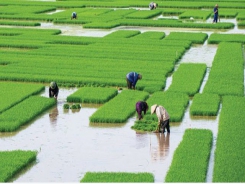Mekong Delta farmers increase area under clean vegetables, fruits for Tết

Farmers tend to their chili field in Tân Nghĩa Commune, Cao Lãnh District of the Mekong Delta province of Đồng Tháp. — VNA/VNS Photo
Ho Chi Minh City – Farmers in the Mekong Delta are sowing various vegetables and fruits for harvest ahead of Tết (Lunar New Year) next February.
The demand for vegetables and fruits is high during Việt Nam’s largest festival, which falls on February 5 next year.
In Cà Mau Province, farmers began planting bitter melon, spring onion, watermelon, and tomato and other vegetables early this month.
Farmers in Lý Văn Lâm Commune, a watermelon growing area in Cà Mau city, are planting 21ha of the fruit to Vietnamese good agricultural practices (VietGAP) standards.
Lê Nhu, who has 2.5ha in Lý Văn Lâm, said: “Planting watermelon based on VietGAP standards has high economic efficiency as it saves fertiliser and pesticide costs.”
If the weather is favourable, farmers could earn VNĐ20 million (US$860) per 1,000sq.m, he said.
They can harvest around three tonnes of the fruit two months after planting.
The local People’s Committee has instructed the Lý Văn Lâm Agriculture Co-operative to ensure its members conform to watermelon growing schedules, the varieties they should grow and the size at which to harvest to meet market demand.
But recent rains in the commune have affected the growing schedule and created conditions for infestation by vegetable pests, giving farmers cause for worry about poor harvest.
Nguyễn Thị Kiều Khuyên, deputy head of the Cà Mau Province Agriculture Extension Centre’s Agriculture Extension Division, said farmers should use various kinds of fertilisers in a balanced manner when growing watermelons rather than using too much nitrate fertilizers if they want to lessen disease outbreaks.
In Đồng Tháp Province, many farmers are planting clean vegetables, including in net houses, to supply for Tết.
Nguyễn Văn Tạo of Long Thuận Commune in Hồng Ngự District has for the first time begun to grow Chinese mustard greens in a net house.
The price of Chinese mustard greens is usually high before Tết as people buy them to make pickled vegetables for eating during the festival, he said.
He has planted 1,500sq.m of the greens, and hopes to earn VNĐ15 million ($640) per 1,000sq.m and supply clean vegetables to the market, he said.
Long Thuận Commune, one of Đồng Tháp’s major vegetable growing areas, has 282ha under various vegetables, including 160ha of clean vegetables, according to its People’s Committee.
The commune supplies around 10 tonnes of various types of vegetables daily, but this is expected to triple just before Tết.
Nguyễn Hữu Hạnh, chairman of the commune People’s Committee, said the area under clean vegetables has increased since the previous Tết.
The commune has instructed farmers to grow vegetables that are in high demand during Tết such as Chinese mustard greens, cauliflower and edible chrysanthemum.
In Long An Province, famers in major vegetable growing areas like Cần Đước and Cần Giuộc districts are planting more spring onion, peppermint, water spinach and other vegetables.
Nguyễn Văn Nam, member of the Phước Hiệp Clean Vegetable Co-operative in Cần Giuộc’s Phước Hậu Commune, said: “Farmers focus on growing vegetables to supply during Tết since they fetch high prices during the festival besides contracting few diseases and result in higher yields at this time of the year.”
From his 2,000sq.m field, he has been earning more than VNĐ30 million ($1,290) by growing vegetables for Tết, he said.
Cần Đước authorities have encouraged farmers and agricultural co-operatives to apply VietGAP standards in growing vegetables, according to the district’s Agriculture and Rural Development Division.
Có thể bạn quan tâm
Phần mềm

Phối trộn thức ăn chăn nuôi

Pha dung dịch thủy canh

Định mức cho tôm ăn

Phối trộn phân bón NPK

Xác định tỷ lệ tôm sống

Chuyển đổi đơn vị phân bón

Xác định công suất sục khí

Chuyển đổi đơn vị tôm

Tính diện tích nhà kính

Tính thể tích ao hồ



 Vietnam’s mushroom market very promising as family incomes…
Vietnam’s mushroom market very promising as family incomes…  Quang Ninh province’s staples to be introduced in…
Quang Ninh province’s staples to be introduced in…